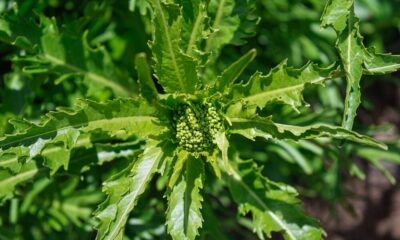Food & Recipes
Guide To Melanin Rich Foods: How Can You Increase Melanin?
Published
3 years agoon


The internal clock of the body is regulated by melatonin. It also regulates the sleep cycle of our body. While exposed to Darkness body tends to produce more melatonin, which triggers sleep in light melatonin production, it gets decreases and activates the body to the away melatonin. It is helpful in the treatment of insomnia Alzheimer’s disease, dementia, chronic obstructive pulmonary disease, irritable bowel syndrome, osteoporosis metabolic syndrome too, and bipolar disease exposure to mobile phones at night creases in the production of melatonin-consuming melanin-rich foods are better than use of melatonin supplements a diet.
It is the pigment that gives the hair, skin, and hair of humans their color. Dark-skinned people have more melanin in their skin than light-skinned people. A cell called melanocytes produces melanin. It provides some protection against skin damage from the sun, and the melanocytes increase their melanin production in response to sun exposure. Which occur in all races and are small concentrated areas of increased melanin production.
What does melanin do in our body?
Melanin plays an essential part in determining the color of your hair, skin, and eyes, especially your genes. They are inherited from your parents. Largely dictate how much melanin you make; people with dark skin have more and however, may look for ways to reduce melanin in the body.
The body makes melanin through several chemical reactions such as melanogenesis. An essential step in this complex sequence is the oxidation of an amino acid called tyrosine, one of several building blocks of protein. The level of melanocyte production creates a difference in appearance among people with light and dark pigmentation, not the number of melanocytes in the skin.
Types of Melanin


Melanin comes in several forms, each contributing to different aspects of pigmentation and protection:
- Eumelanin: This is the most common type of melanin found in human skin and hair. It is primarily responsible for brown and black hues. Eumelanin is further divided into two subtypes:
- Brown Eumelanin: Found predominantly in individuals with darker skin and hair.
- Black Eumelanin: Contributes to the deep, black coloration in hair and skin.
- Pheomelanin: This type of melanin provides red and yellow pigments and is most commonly found in individuals with lighter skin, red hair, and freckles. Unlike eumelanin, pheomelanin does not offer significant protection against ultraviolet (UV) radiation.
- Neuromelanin: Found in the brain, neuromelanin’s primary role is still under research, but it is believed to play a part in protecting neurons and maintaining healthy brain function.
The Role of Melanin in the Body
Melanin’s role extends beyond simply coloring the skin, hair, and eyes. It has several important functions that contribute to overall health and protection.
1. Protective Effects Against UV Radiation
One of the most crucial roles of melanin is its ability to protect the skin from the harmful effects of UV radiation from the sun. Here’s how melanin works as a natural sunscreen:
- Absorption of UV Rays: Melanin absorbs harmful UV rays, preventing them from penetrating deeper into the skin layers where they can cause DNA damage. This reduces the risk of skin cancer and other UV-induced skin conditions.
- Neutralization of Free Radicals: UV radiation can lead to the formation of free radicals, which are unstable molecules that can damage cells and contribute to aging and diseases. Melanin helps neutralize these free radicals, thereby protecting the skin from oxidative stress.
2. Role in Eye Health
Melanin is also present in the eyes, particularly in the iris and the retinal pigment epithelium (RPE). It plays several roles in maintaining eye health:
- Light Absorption: Melanin in the iris helps regulate the amount of light entering the eye, protecting the retina from excessive light exposure.
- Protection Against UV Damage: Similar to its role in the skin, melanin in the eyes absorbs UV rays, preventing them from causing damage to the delicate tissues of the eye.
- Prevention of Age-Related Macular Degeneration (AMD): Research suggests that melanin may help reduce the risk of AMD, a leading cause of vision loss in older adults, by protecting retinal cells from oxidative stress.
Additional Health Benefits of Melanin
While its protective role against UV radiation and contribution to eye health are well-documented, melanin offers several other health benefits:
1. Anti-Inflammatory Properties
Melanin has been found to exhibit anti-inflammatory properties. This means that it can help reduce inflammation in the body, which is beneficial for overall health, as chronic inflammation is linked to various diseases, including arthritis, heart disease, and certain cancers.
2. Antioxidant Effects
As an antioxidant, melanin helps combat oxidative stress by neutralizing free radicals. This is essential for protecting cells from damage and reducing the risk of chronic diseases. By mitigating oxidative stress, melanin contributes to healthier skin, lower cancer risk, and better overall health.
3. Neurological Protection
Neuromelanin, found in the brain, is believed to protect neurons from oxidative damage and other stressors. This can be crucial for maintaining cognitive function and preventing neurodegenerative diseases such as Parkinson’s disease and Alzheimer’s disease. Although research is ongoing, the protective role of neuromelanin is a promising area of study in understanding brain health.
4. Regulation of Body Temperature
Melanin also plays a role in regulating body temperature. By influencing how the body absorbs and radiates heat, melanin helps maintain a stable internal temperature, which is vital for overall metabolic processes and homeostasis.
Melanin rich foods are given below
1. Tart cherry :


Tart cherries are rich in melatonin. Newtonian banana provides melatonin in plant nutrient banana contains potassium, calcium, manganese, magnesium, iron, folate, niacin, riboflavin and vitamin B6 3
2. Tomatoes:


Tomatoes are well-endowed in May. The tone in tomatoes also contains vitamin E Alpha tropospheric thiamin niacin vitamin B6 folate magnesium. Phosphorous and copper.
3. Carrot:


It is an excellent source of dietary fiber vitamin A. Vitamin C, vitamin K potassium, and manganese 400 rich in melatonin provide a sufficient amount of fiber and contain beta-glucan antioxidants, minerals, and vitamins in plenty. Besides, it regulates blood sugar levels and cholesterol levels.
4. Pineapple:


Pineapple provides a sufficient amount of melatonin to the body. It is also rich in manganese, and it is also when a down in vitamin C vitamin B1 vitamin B6 proper dietary fiber folate and pantothenic acid.
5. Dark Chocolate:


Dark chocolate is a vitamin-rich superfood with very great overall health benefits. It eventually blocks the breakdown of collagen, and it is known to replace lost moisture in our skin. Dark chocolate is rich in nourishing antioxidants, vitamins, and minerals for dry skin—the flavor in dark chocolate helps protect from sunburn.
Lifestyle Factors Affecting Melanin Levels
Melanin, the pigment responsible for the color of our skin, hair, and eyes, is influenced by various lifestyle factors. Understanding how sun exposure, stress management, and sleep can impact melanin production helps in making informed choices to maintain healthy melanin levels.
Sun Exposure
How Sun Exposure Affects Melanin Production:
Sun exposure is one of the most significant factors affecting melanin production. When our skin is exposed to ultraviolet (UV) rays from the sun, it triggers melanocytes (melanin-producing cells) to produce more melanin as a defense mechanism. This process helps protect the skin from UV radiation damage by absorbing and dissipating the harmful rays.
Practical Tips:
- Moderate Sun Exposure: Aim for moderate sun exposure to stimulate melanin production without causing skin damage. About 10-15 minutes of sun exposure several times a week can be beneficial. Always wear sunscreen with adequate SPF to protect your skin from overexposure.
- Time of Day: Try to get sun exposure during the early morning or late afternoon when UV radiation is less intense.
- Protective Clothing: Wear protective clothing, hats, and sunglasses to minimize direct exposure to harsh sunlight while allowing some natural light to reach your skin.
For more information on safe sun exposure, check out this guide by the Skin Cancer Foundation
Stress Management
How Stress Affects Melanin Production:
Chronic stress can disrupt hormonal balance in the body, affecting melanin production. High levels of stress can lead to the release of cortisol, a hormone that can interfere with melanin synthesis. This may result in uneven skin pigmentation or conditions like vitiligo, where melanin production is diminished in certain areas of the skin.
Practical Tips:
- Relaxation Techniques: Incorporate relaxation techniques such as deep breathing exercises, meditation, or yoga into your daily routine to reduce stress levels.
- Physical Activity: Engage in regular physical activity to help manage stress. Exercise promotes the release of endorphins, which are natural stress relievers.
- Adequate Rest: Ensure you are getting enough rest and downtime to recover from daily stresses. Prioritize activities that you enjoy and that help you relax.
For more strategies on managing stress, visit this resource from the American Psychological Association
Sleep
How Sleep Affects Melanin Production:
Adequate sleep is crucial for overall health and well-being, including melanin production. During sleep, the body undergoes repair and regeneration processes. Poor sleep quality or insufficient sleep can disrupt these processes and affect hormone levels, potentially impacting melanin production.
Practical Tips:
- Establish a Routine: Stick to a regular sleep schedule by going to bed and waking up at the same time every day, even on weekends.
- Create a Sleep-Conducive Environment: Ensure your sleeping environment is dark, quiet, and cool. Consider using blackout curtains and white noise machines if necessary.
- Limit Screen Time: Reduce exposure to screens (phones, computers, TVs) at least an hour before bedtime, as blue light can interfere with melatonin production, the hormone responsible for regulating sleep.
For more tips on improving sleep quality, check out this guide Sleep Hygiene Practices: Promoting Healthy Sleep Habits for Better Rest
Important information
Melanin is also important for hair. Melanin is that pigment that gives natural color to hair and eyes. The more the melanin, the darker will be the color! For instance, here are some super doings of the pigment-
- Regulates hair color
- Protects hair from sun rays
- Reduces stress
You can also increase melanin in your body by doing performing these medicated steps:
- Skin peeling
- Microblading
- Microderbmation
- Laser resurfacing
Q&A
1: How quickly can I expect to see results from eating these foods to boost Melanin?
A: The speed at which you will see results will depend on several factors, including your current diet, lifestyle, and overall health. In general, it may take several weeks to several months to see significant changes in skin color and melanin levels.
2: Are there any side effects of consuming these foods to boost Melanin?
A: In general, these foods are considered safe for most people when consumed in moderation. However, some people may experience side effects, such as an upset stomach or allergic reactions, especially if they have a history of food allergies. It is always a good idea to talk to your doctor before making any significant changes to your diet.
3: Can I still use sunscreen if I want to boost my Melanin levels naturally?
A: Yes, it is still important to use sunscreen, even if you are trying to boost your melanin levels naturally. Sunscreen helps to protect your skin from harmful UV rays, which can cause skin damage, premature aging, and skin cancer.
4: Can I still get a tan if I boost my Melanin levels naturally?
A: Yes, you can still get a tan if you boost your melanin levels naturally. When your skin is exposed to the sun, the melanocytes in your skin produce more melanin, causing your skin to darken, or tan.
5: Is it safe to consume these foods during pregnancy?
A: It is always a good idea to talk to your doctor before making any changes to your diet, especially during pregnancy. Some of these foods, such as shellfish, may contain high levels of mercury, which can be harmful to the developing fetus.
6: Can these foods also help boost Melanin in the eyes and hair?
A: Yes, the foods that help to boost melanin in the skin can also help to boosts melanin in the eyes and hair. The same principles apply, as these foods provide the body with the necessary nutrients and building blocks for melanin production.
7: Can these foods also help to reduce hyperpigmentation and age spots?
A: Yes, some of these foods, such as Vitamin C-rich foods, can help to reduce hyperpigmentation and age spots. Vitamin C acts as an antioxidant and helps to protect the skin from damage, which can lead to hyperpigmentation and age spots.
8: Can I eat too much of these foods and harm my health?
A: Yes, it is possible to eat too much of these foods and harm your health. It is important to eat a balanced diet and to not consume large amounts of any one food. Overconsumption of certain foods, such as shellfish, which are high in copper, can lead to toxicity and health problems.
9: Are there any foods to avoid if I want to boost Melanin levels naturally?
A: There are no specific foods to avoid if you want to boost melanin levels naturally. However, it is a good idea to avoid processed and junk foods, which can be high in sugar, salt, and unhealthy fats. These foods can be damaging to the skin and can lead to skin problems, such as acne and wrinkles.
10: Are there any supplements or creams that can help to boost Melanin levels?
A: There are supplements and creams that claim to help boost melanin levels. However, it is important to note that these products have not been scientifically proven to be effective and may not be safe for everyone. It is always a good idea to talk to your doctor.
11: What are the 5 foods that boost Melanin in the body naturally?
A: The 5 foods to boost Melanin in the body naturally are: Copper-rich foods such as shellfish, nuts, and leafy greens, Vitamin C-rich foods like citrus fruits, strawberries, and bell peppers, Tyrosine-rich foods like soy, dairy, and lean meats, Echinacea root, and Black seeds.
12: How does Copper help boost Melanin in the body?
A: Copper is an essential mineral that helps in the production of melanin. It activates the tyrosinase enzyme, which is responsible for the synthesis of melanin.
13: Can Vitamin C help boost Melanin?
A: Yes, Vitamin C is known to boost melanin production in the body. It acts as an antioxidant and helps to protect the skin from damage caused by harmful UV rays. Vitamin C also promotes collagen production, which helps to keep the skin firm and healthy.
14: What are Tyrosine-rich foods and how do they help boost Melanin?
A: Tyrosine is an amino acid that is essential for the production of melanin. Tyrosine-rich foods include soy, dairy, and lean meats. These foods help to boost melanin production by providing the body with the necessary building blocks for the synthesis of melanin.
15: What is Echinacea root and how does it help boost Melanin?
A: Echinacea root is a plant commonly used in herbal medicine. It is known to have a positive impact on the immune system and skin health. Echinacea root is believed to boost melanin production by increasing the activity of melanocytes, which are responsible for producing melanin.
16: What are Black Seeds and how do they help boost Melanin?
A: Black Seeds, also known as Nigella sativa, are small black seeds with a long history of use in traditional medicine. They are believed to have numerous health benefits, including boosting melanin production in the skin. This is because they contain a high concentration of antioxidants and anti-inflammatory compounds, which help to protect the skin from damage and promote healthy skin.
17: Can I boost Melanin in my hair as well?
A: Melanin is responsible for the color of your hair as well as your skin and eyes. Incorporating foods that support melanin production into your diet can help to maintain or improve the color of your hair over time. Incorporate these foods to boost the melanin in your hair.
18: Can boosting Melanin help reduce the appearance of age spots?
A: Age spots are a result of sun exposure and skin damage. Boosting Melanin in the body through a healthy diet can help to protect the skin from further damage and may potentially reduce the appearance of age spots over time.
19: Can I boost Melanin in the body during pregnancy?
A: It is best to consult with a healthcare provider before making any changes to your diet or supplements during pregnancy. While boosting Melanin in the body through a healthy diet is generally safe, it is important to ensure that the diet provides all the necessary nutrients for both you and your baby.
20: Can boosting Melanin in the body improve eye color?
A: Melanin is responsible for the color of the iris in the eye, and while a healthy diet can support overall Melanin production, it is unlikely to significantly change the color of your eyes.
21: Can boosting Melanin in the body affect skin sensitivity to sun exposure?
A: Boosting Melanin in the body can help to protect the skin from harmful UV radiation from the sun. However, it is still important to use sun protection, such as wearing protective clothing and using sunscreen, to reduce the risk of sunburn and skin damage.
Final word
Now, when we know the importance of melanin and we have an idea of food rich in melanin. We have to focus on our body, on our diet. After all, our body is our temple!
About the author
Alisha George
- November 30, 2021
- January 24, 2022
Food & Recipes
Wild Lettuce: Know Wild Lettuce Benefits, Side Effects & More
Wild lettuce, scientifically known as Lactuca virosa, is a biennial plant belonging to the Asteraceae family. Native to Europe and Asia, this herbaceous species is widely cultivated for its medicinal and culinary uses.
Published
2 months agoon
May 17, 2024By
David

What is Wild Lettuce?
Wild lettuce, scientifically known as Lactuca Virosa, is a biennial plant belonging to the Asteraceae family. Native to Europe and Asia, this herbaceous species is widely cultivated for its medicinal and culinary uses. Also referred to as “opium lettuce” due to its mild sedative effects, wild lettuce has a long history of traditional use dating back to ancient civilizations.
The plant has deeply lobed leaves and little yellow flowers that bloom in bunches. It normally reaches a height of 3 to 7 feet. You can find wild lettuce growing in meadows, woodlands, and by the sides of roads in temperate areas. Because of its adaptability and persistence, it is frequently seen in both urban and rural environments.
Wild lettuce has long been valued for its medicinal qualities as well as being seen as a representation of life and wellbeing. Ancient societies, including the Greeks, Romans, and Egyptians, appreciated the sedative, analgesic, and anti-inflammatory qualities of wild lettuce. It was frequently applied to reduce pain, encourage calmness, and bring on sleep.
In contemporary times, wild lettuce continues to be cherished for its medicinal benefits and is widely used in herbal medicine practices around the world. Its leaves and sap contain a milky latex substance known as lactucarium, which is rich in bioactive compounds such as lactucin and lactucopicrin. These compounds are believed to contribute to the plant’s sedative and analgesic effects, making it a popular remedy for conditions such as insomnia, anxiety, and migraine headaches.
Despite its long history of traditional use, wild lettuce remains a subject of scientific inquiry, with ongoing research aimed at uncovering its pharmacological properties and potential therapeutic applications. As interest in natural remedies and alternative medicine continues to grow, wild lettuce holds promise as a valuable botanical resource for promoting health and well-being.
Can We Eat Wild Lettuce
The answer is that wild lettuce is edible, and you can eat the leaves and stems of the plant. Nevertheless, care must be taken when gathering and cooking wild lettuce for eating. Some people may find the bitter flavour of certain wild lettuce species to be intolerable.
Furthermore, some people may respond negatively to some substances found in wild lettuce, particularly if they ingest excessive amounts of it or if they have particular sensitivities or allergies.
Consequently, it is best to start modestly while consuming wild lettuce in order to monitor your body’s response and make sure the plant is being harvested in a clean and healthy setting.
As with any wild plant, it is crucial to positively identify the species and to avoid harvesting from areas that may be exposed to pollutants or pesticides. If you have any concerns or medical conditions, it is best to consult with a healthcare professional before consuming wild lettuce or any other wild plant for culinary or medicinal purposes.
The Medicinal Uses of Wild Lettuce
Wild lettuce has a long history of use in traditional medicine for its various medicinal properties. From alleviating pain to promoting relaxation, this versatile plant offers a range of therapeutic benefits that have been recognized and valued for centuries.
1. Pain relief:
Wild lettuce has been traditionally used to alleviate pain associated with various conditions such as headaches, muscle aches, and joint pain. Research suggests that wild lettuce contains compounds like lactucin and lactucopicrin, which exhibit analgesic properties by acting on the central nervous system to reduce pain perception (source).
2. Sedative properties:
The milky sap of wild lettuce contains lactucarium, a substance known for its sedative effects. Studies have shown that lactucarium acts as a mild sedative and can help promote relaxation and improve sleep quality (source).
3. Anxiety and stress relief:
Wild lettuce may help alleviate symptoms of anxiety and stress due to its calming effects on the nervous system. Research indicates that wild lettuce extracts have anxiolytic properties, making them useful in managing stress and anxiety (source).
4. Respiratory support:
Wild lettuce has been used to relieve respiratory conditions such as asthma and bronchitis. Studies suggest that compounds in wild lettuce possess expectorant and bronchodilator effects, which can help improve breathing and relieve coughs (source).
5. Digestive aid:
The bitter compounds in wild lettuce can stimulate digestive function, improve appetite, and alleviate symptoms of indigestion. Research shows that wild lettuce extracts may have gastroprotective effects and help reduce gastric acid secretion (source).
6. Mild diuretic:
Wild lettuce can act as a mild diuretic, promoting urine production and helping to eliminate excess fluid and toxins from the body. Studies suggest that wild lettuce extracts may increase urine output and support kidney function (source).
7. Anti-inflammatory effects:
Compounds found in wild lettuce may help reduce inflammation and swelling, making it beneficial for conditions such as arthritis. Research indicates that wild lettuce extracts exhibit anti-inflammatory activity by inhibiting inflammatory mediators (source).
8. Nervous system support:
Wild lettuce is believed to have a tonic effect on the nervous system, helping to calm nerves and reduce irritability. Studies suggest that wild lettuce extracts may modulate neurotransmitter levels in the brain, contributing to its calming effects (source).
9. Menstrual cramp relief:
Some women use wild lettuce to alleviate menstrual cramps and discomfort during menstruation. While scientific research on this specific use is limited, anecdotal evidence suggests that wild lettuce may help reduce menstrual pain and cramping.
10. Fever reducer:
Wild lettuce has been traditionally used to lower fever and promote sweating during febrile illnesses. However, more research is needed to fully understand its mechanisms of action and effectiveness in reducing fever.
11. Antispasmodic properties:
Wild lettuce may help relieve muscle spasms and cramps due to its antispasmodic effects on smooth muscle tissue. Studies suggest that wild lettuce extracts can relax muscle contractions and alleviate spasms (source).
12. Liver support:
Consuming wild lettuce may support liver function and detoxification processes. While there is limited direct research on this aspect, the liver-supporting properties of bitter herbs like wild lettuce are well-documented in traditional medicine (source).
13. Hypnotic effects:
Wild lettuce preparations have been used to induce a state of mild euphoria and relaxation, promoting restful sleep and reducing insomnia. Studies suggest that wild lettuce extracts may have sedative-hypnotic effects, aiding in sleep induction (source).
14. Traditional remedy for opiate withdrawal:
Wild lettuce has been historically used as a natural remedy to help ease symptoms of opiate withdrawal, such as anxiety, restlessness, and insomnia. While scientific evidence is limited, anecdotal reports suggest that wild lettuce may offer relief during the withdrawal process.
15. Skin conditions:
Wild lettuce sap has been applied topically to soothe skin irritations, rashes, and insect bites. While there is limited scientific research on this specific use, the anti-inflammatory and analgesic properties of wild lettuce may help alleviate skin discomfort (source).
Potential Side Effects of Wild Lettuce
1. Allergic reactions:
Some individuals may experience allergic reactions to wild lettuce, leading to symptoms such as skin rash, itching, swelling, or difficulty breathing. Allergic reactions can vary in severity, and it’s essential to discontinue use if any adverse reactions occur (source).
2. Gastrointestinal discomfort:
Consuming wild lettuce may cause gastrointestinal discomfort in some people, including symptoms like nausea, vomiting, diarrhea, or abdominal pain. These effects can be due to the bitter compounds present in wild lettuce, which may irritate the digestive tract (source).
3. Drowsiness and dizziness:
Wild lettuce’s sedative properties may cause drowsiness or dizziness, especially when consumed in large amounts or in combination with other sedative substances. These effects can impair cognitive function and motor skills, increasing the risk of accidents or injuries (source).
4. Hypotension:
Some individuals may experience a drop in blood pressure after consuming wild lettuce, leading to symptoms of hypotension such as lightheadedness, fainting, or weakness. Individuals with low blood pressure or those taking antihypertensive medications should use wild lettuce with caution (source).
5. Photosensitivity:
Certain compounds in wild lettuce sap may increase sensitivity to sunlight, leading to sunburn or skin irritation upon exposure to UV rays. Individuals using wild lettuce topically should avoid prolonged sun exposure to prevent skin reactions (source).
6. Potential drug interactions:
Wild lettuce may interact with certain medications, including sedatives, antihypertensives, and blood thinners. These interactions can potentiate the effects of medications or interfere with their metabolism, leading to adverse reactions or reduced efficacy (source).
7. Liver toxicity:
In rare cases, excessive consumption of wild lettuce may lead to liver toxicity or liver damage. This adverse effect is more likely to occur with prolonged or high-dose use of wild lettuce preparations (source).
8. Respiratory depression:
Wild lettuce’s sedative properties may cause respiratory depression in susceptible individuals, particularly those with respiratory conditions like asthma or chronic obstructive pulmonary disease (COPD). Respiratory depression can lead to breathing difficulties or even respiratory failure in severe cases (source).
9. Pregnancy and breastfeeding:
Pregnant and breastfeeding women should avoid using wild lettuce due to a lack of safety data. Wild lettuce may exert uterine-stimulating effects and pose risks to fetal development or infant health (source).
10. Psychological effects:
In some cases, wild lettuce may induce psychological effects such as confusion, hallucinations, or altered perception. These effects are more likely to occur with high doses or prolonged use of wild lettuce and can be distressing or disorienting (source).
About the author
David is a blogger for over 15 years now and writes on health and wellness. The articles are focused to give extensive information about the subject.
- June 30, 2020
- June 30, 2020
- June 30, 2020
Food & Recipes
Best Juices To Boost Immune System For a Stronger Defense
Published
4 months agoon
April 3, 2024By
Charlotte

In today’s fast-paced world, maintaining a robust immune system is crucial for overall health and well-being. While a balanced diet rich in fruits and vegetables forms the cornerstone of immune health, incorporating immunity-boosting juices into your daily routine can provide an extra layer of protection against illness. In this comprehensive guide, we delve into the benefits of immunity-boosting juices and share delicious recipes to help fortify your body’s natural defenses.
Immunity Booster Drink: The Power of Healthy Juices
1. Watermelon-Mint Immunity Juice:


- Ingredients: Fresh watermelon chunks, mint leaves, lime juice.
- Benefits: Watermelon is a rich source of vitamin C, antioxidants, and electrolytes, making it an ideal ingredient for boosting immune function. Mint leaves not only impart a refreshing flavor but also contain compounds that support digestion and overall well-being. Lime juice adds an extra dose of vitamin C, further enhancing the immune-boosting properties of this juice.
- Recipe: To prepare this refreshing elixir, simply blend fresh watermelon chunks and mint leaves until smooth. Squeeze in some fresh lime juice for added zest. Serve chilled for a hydrating and invigorating boost to your immune system.
Nutrients
- Vitamin C from watermelon and lime
- Hydration from watermelon and coconut water
- Antioxidants from watermelon and mint
2. Citrus Immunity Blast:


- Ingredients: Oranges, grapefruits, lemons, ginger.
- Benefits: Citrus fruits like oranges, grapefruits, and lemons are renowned for their high vitamin C content, which plays a crucial role in supporting immune health. These fruits also provide essential antioxidants that help combat oxidative stress and inflammation. Ginger adds an extra layer of immune support with its anti-inflammatory and antimicrobial properties.
- Recipe: Juice fresh oranges, grapefruits, and lemons to extract their vibrant and tangy flavors. Add freshly grated ginger for an additional boost of immune-boosting goodness. Enjoy this invigorating citrus blast over ice for a refreshing and revitalizing way to support your immune system.
Nutrients
- Vitamin C from oranges and lemons
- Vitamin A from carrots
- Antioxidants from oranges, carrots, and turmeric
- Hydration from coconut water
3. Green Goddess Elixir:


- Ingredients: Spinach, kale, cucumber, apples, lemon.
- Benefits: Eating leafy greens like spinach and kale are nutritional powerhouses, packed with vitamins A, C, and K, as well as essential minerals and antioxidants. These nutrients help bolster immune function and protect against illness. Cucumber adds hydration and a refreshing crunch, while apples and lemon provide natural sweetness and acidity.
- Recipe: Blend together fresh spinach, kale, cucumber, apples, and lemon until smooth. Strain the mixture if desired, then sip on this nutrient-rich elixir to nourish your body and support your immune system. This Green Goddess Elixir is a delicious and rejuvenating way to boost your overall health.
Nutrients
- Vitamin A, C, and K from spinach and cucumber
- Calcium from spinach
- Iron from spinach
- Magnesium from spinach and cucumber
- Potassium from spinach and cucumber
- Antioxidants from spinach, cucumber, celery, and lemon
- Hydration from cucumber and celery
- Detoxifying properties from spinach, cucumber, celery, lemon, and parsley
4. Berry Blast Immunity Booster:


- Ingredients: Mixed berries (strawberries, blueberries, raspberries), spinach, Greek yogurt, honey.
- Benefits: Berries are packed with antioxidants, vitamins, and minerals that help strengthen the immune system and protect against free radical damage. Spinach adds additional vitamins and minerals, while Greek yogurt contributes probiotics that support gut health and overall immune function. Honey provides natural sweetness and antimicrobial properties.
- Recipe: Blend together a mix of fresh berries, spinach, Greek yogurt, and honey until smooth and creamy. Adjust the sweetness to taste, then enjoy this delicious and nutritious Berry Blast Immunity Booster as a satisfying snack or meal replacement. This vibrant and flavorful juice is sure to keep your immune system strong and resilient.
Nutrients
- Vitamin C from strawberries and oranges
- Antioxidants from berries and spinach
- Fiber from berries and spinach
- Hydration from coconut water
5. Tropical Turmeric Tonic:


- Ingredients: Pineapple, mango, turmeric root, ginger, coconut water.
- Benefits: Pineapple and mango are tropical fruits rich in vitamins A and C, which are essential for immune function. Turmeric and ginger both have potent anti-inflammatory and antioxidant properties that can help strengthen the immune system and reduce inflammation. Coconut water provides hydration and electrolytes, making this tonic both refreshing and nourishing.
- Recipe: Blend together chunks of fresh pineapple and mango with grated turmeric root, ginger, and coconut water until smooth. Strain the mixture if desired, then pour into glasses and garnish with a slice of pineapple or a sprig of mint. Sip on this Tropical Turmeric Tonic to give your immune system a tropical boost and enjoy the vibrant flavors of the islands.
Nutrients
- Vitamin C from pineapple
- Antioxidants from pineapple, mango, turmeric, and ginger
- Electrolytes and hydration from coconut water
6. Beetroot Bliss Booster:


- Ingredients: Beetroot, carrots, oranges, ginger, honey.
- Benefits: Beetroot is rich in immune-boosting nutrients like vitamin C, folate, and manganese, as well as powerful antioxidants called betalains. Carrots provide additional vitamins and minerals, while oranges add a zesty burst of vitamin C. Ginger and honey contribute antimicrobial properties and natural sweetness, respectively.
- Recipe: Juice fresh beetroot, carrots, and oranges to extract their vibrant colors and flavors. Add freshly grated ginger and a drizzle of honey to enhance the taste and nutritional value. Enjoy this Beetroot Bliss Booster as a delicious and invigorating way to support your immune system and promote overall health.
Nutrients
- Vitamin C from oranges
- Folate, manganese, and betalains from beetroot
- Antioxidants from beetroot, carrots, and oranges
7. Pomegranate Power Punch:


- Ingredients: Pomegranate seeds, strawberries, spinach, lemon, honey.
- Benefits: Pomegranate seeds are packed with antioxidants, particularly punicalagins and anthocyanins, which help boost immune function and reduce inflammation. Strawberries provide additional vitamin C and fiber, while spinach adds vitamins A and K. Lemon adds a citrusy kick and extra vitamin C, while honey lends natural sweetness and antimicrobial properties.
- Recipe: Blend together fresh pomegranate seeds, strawberries, spinach, lemon juice, and honey until smooth and creamy. Pour into glasses and garnish with a slice of lemon or a few pomegranate arils. Sip on this vibrant and nutrient-rich Pomegranate Power Punch to give your immune system a powerful boost and enjoy the delicious flavors of summer.
Nutrients
- Vitamin C from pomegranate seeds and lemon
- Antioxidants from pomegranate seeds, strawberries, and spinach
- Fiber from strawberries and spinach
8. Detoxifying Green Cleanse:
- Ingredients: Cucumber, celery, kale, green apples, lemon, parsley.
- Benefits: This green juice is packed with detoxifying ingredients that help cleanse the body and support immune health. Cucumber and celery are hydrating and low in calories, while kale provides vitamins A, C, and K. Green apples add natural sweetness, while lemon and parsley provide additional vitamin C and antioxidants.
- Recipe: Juice together cucumber, celery, kale, green apples, lemon juice, and parsley until well combined. Strain the mixture if desired, then pour into glasses and enjoy this Detoxifying Green Cleanse as a refreshing and revitalizing way to support your immune system and promote overall wellness.
Nutrients
- Vitamin A, C, and K from kale
- Hydration from cucumber and celery
- Detoxifying properties from kale, cucumber, celery, and parsley
By incorporating these immunity-boosting juices into your daily routine, you can provide your body with the essential nutrients it needs to stay healthy and resilient. Whether enjoyed as a refreshing beverage or a post-workout pick-me-up, these delicious juices offer a convenient and delicious way to support your immune system and promote overall well-being.
About the author



Charlotte
Charlotte is a health, beauty and wellness blogger and a mother of two, who lives between India and London
- July 22, 2020
- August 3, 2020
- August 10, 2020
Food & Recipes
Diabetic-Friendly Delights: Nourishing Recipes for Managing Blood Sugar
Living with diabetes necessitates meticulous attention to your diet to maintain optimal blood sugar levels and overall health. Through a carefully curated selection of recipes and insightful guidance, this comprehensive guide is designed to empower you with the knowledge
Published
4 months agoon
March 26, 2024By
Charlotte

Living with diabetes necessitates meticulous attention to your diet to maintain optimal blood sugar levels and overall health. Through a carefully curated selection of recipes and insightful guidance, this comprehensive guide is designed to empower you with the knowledge and tools to make informed dietary choices that support blood sugar control while savoring the pleasures of a delicious and nourishing meal plan.
Understanding Diabetes Management Through Diet


Embark on a journey into the realm of diet and diabetes, where the crucial link between what you eat and blood sugar control becomes evident. This section delves into the nuances of balancing your diet to maintain stable blood sugar levels, revealing how strategic meal planning contributes to overall wellness.
The Importance of Balanced Nutrition
Discover the power of balanced nutrition in managing diabetes. We unravel the significance of incorporating nutrient-rich foods that provide essential vitamins, minerals, and antioxidants while helping to keep blood sugar levels in check. Learn how to create harmonious meals that cater to your taste buds and your health.
Incorporating Low Glycemic Index (GI) Foods


Navigate the world of glycemic index foods, where the speed at which carbohydrates affect blood sugar levels is demystified. Dive into a selection of low GI recipes that embrace wholesome ingredients, allowing you to indulge in satisfying meals without compromising blood sugar control.
Sweetening Naturally
Bid farewell to refined sugars and explore the realm of natural sweeteners. Delve into alternatives such as stevia, monk fruit, and honey, discovering innovative ways to infuse sweetness into your dishes while maintaining stable blood sugar levels.
Protein-Packed Pleasures


Unlock the secrets of protein’s role in managing diabetes. Beyond its muscle-building attributes, protein contributes to steady blood sugar levels. Explore a variety of high-protein meals, recognizing how they promote muscle health and assist in maintaining balanced glucose levels.
Smart Carbohydrate Choices
Navigate the complex world of carbohydrates with wisdom. Discover how to identify diabetes-friendly carbs, explore the benefits of whole grains, and understand the impact of carbohydrates on blood sugar levels. Make informed choices to enjoy sustained energy and well-being.
Heart-Healthy Fats


Learn the importance of heart-healthy fats in diabetes care. This section highlights the significance of omega-3 fatty acids and monounsaturated fats, shedding light on their role in supporting cardiovascular health and blood sugar management.
Healthy Cooking Methods
Discover the art of cooking for blood sugar control. Uncover cooking methods that preserve nutrients and flavors while minimizing the impact on blood sugar levels. From grilling to steaming, explore techniques that elevate your culinary endeavors.
Colorful Fruits and Vegetables


Embrace a vibrant palette of fruits and vegetables that not only add color to your plate but also offer a treasure trove of essential nutrients. The rainbow diet is unveiled, showcasing how these nutrient-rich foods can contribute to your overall well-being.
Diabetes and Hydration


Staying hydrated is often overlooked in diabetes care. Recognize the profound influence of proper hydration on blood sugar management and overall health. Learn about the role of water intake in supporting your well-being.
Embrace this journey toward diabetic-friendly delights, where each recipe and insight is tailored to empower you in your pursuit of balanced blood sugar levels and holistic well-being. By understanding the nuances of nutrition, making informed food choices, and crafting meals that harmonize with your diabetes management goals, you’re embarking on a path of wellness that nourishes both body and spirit.
Living with diabetes doesn’t mean sacrificing flavor or indulgence. In fact, it’s an opportunity to explore a world of delectable and nourishing dishes that support your blood sugar management while satisfying your taste buds. This blog presents a collection of mouthwatering recipes that embrace the principles of balanced nutrition, low glycemic index (GI) foods, and mindful ingredient choices. Get ready to embark on a culinary journey that combines taste and health in perfect harmony.
Nourishing Recipes for Managing Blood Sugar
Recipe 1: Quinoa-Stuffed Bell Peppers
Ingredients:
- 4 large bell peppers (any color)
- 1 cup quinoa, rinsed
- 2 cups low-sodium vegetable broth
- 1 can (15 oz) black beans, drained and rinsed
- 1 cup corn kernels (fresh or frozen)
- 1 cup diced tomatoes
- 1 teaspoon cumin
- 1 teaspoon paprika
- Salt and pepper to taste
- Chopped fresh cilantro for garnish
Instructions:
- Preheat the oven to 375°F (190°C).
- Cut the tops off the bell peppers and remove the seeds and membranes.
- In a medium saucepan, bring the vegetable broth to a boil. Add the quinoa, reduce heat to low, cover, and let it simmer for about 15 minutes or until the liquid is absorbed.
- In a large bowl, combine the cooked quinoa, black beans, corn, diced tomatoes, cumin, paprika, salt, and pepper. Mix well.
- Stuff each bell pepper with the quinoa mixture and place them in a baking dish.
- Cover the baking dish with aluminum foil and bake for 25-30 minutes, or until the peppers are tender.
- Garnish with chopped cilantro before serving.
Recipe 2: Baked Salmon with Asparagus
Ingredients:
- 2 salmon fillets
- 1 bunch asparagus, trimmed
- 2 tablespoons olive oil
- 1 lemon, sliced
- 2 cloves garlic, minced
- Salt and pepper to taste
Instructions:
- Preheat the oven to 400°F (200°C).
- Place the salmon fillets and asparagus on a baking sheet lined with parchment paper.
- Drizzle olive oil over the salmon and asparagus. Sprinkle minced garlic, salt, and pepper.
- Place lemon slices on top of the salmon fillets.
- Bake in the preheated oven for about 15-20 minutes or until the salmon flakes easily with a fork and the asparagus is tender.
- Serve with a squeeze of fresh lemon juice.
Recipe 3: Greek Yogurt Parfait
Ingredients:
- 1 cup plain Greek yogurt
- 1/2 cup mixed berries (blueberries, strawberries, raspberries)
- 1 tablespoon chopped nuts (almonds, walnuts)
- 1 teaspoon chia seeds
- 1 teaspoon honey (optional)
Instructions:
- In a glass or bowl, layer half of the Greek yogurt.
- Add a layer of mixed berries on top of the yogurt.
- Sprinkle chopped nuts and chia seeds over the berries.
- Add the remaining Greek yogurt on top.
- Drizzle honey over the yogurt, if desired.
- Enjoy as a nutritious and satisfying dessert or snack.
These recipes exemplify the essence of diabetic-friendly delights—delicious, nutritious, and mindful of blood sugar levels. By incorporating these recipes into your meal plan, you’re embracing a journey of wellness and culinary exploration. Remember, managing diabetes doesn’t mean giving up on the joy of food; it’s about making choices that nourish your body and elevate your overall well-being.
About the author



Charlotte
Charlotte is a health, beauty and wellness blogger and a mother of two, who lives between India and London
- July 22, 2020
- August 3, 2020
- August 10, 2020
Trending
-



 Health & Wellness4 months ago
Health & Wellness4 months agoRosemary Leaves For Hair: Benefits and How To Use It
-



 Love & Relationship2 months ago
Love & Relationship2 months agoUnderstanding the Psychology Behind Infidelity: Why Do People Cheat in Relationships?
-



 Health & Wellness3 months ago
Health & Wellness3 months agoUnderstanding Low Blood Pressure: Symptoms & Causes Of Hypotension
-



 Health & Wellness4 months ago
Health & Wellness4 months agoSay Goodbye to Double Chin: 8 Effective Double Chin Exercises
-



 Food & Recipes4 months ago
Food & Recipes4 months agoBest Juices To Boost Immune System For a Stronger Defense
-



 Health & Wellness4 months ago
Health & Wellness4 months agoLow Porosity Hair: Important Things You Need To Know
-



 Food & Recipes2 months ago
Food & Recipes2 months agoWild Lettuce: Know Wild Lettuce Benefits, Side Effects & More
-



 Health & Wellness3 months ago
Health & Wellness3 months ago9 Effective Weight Gain Exercise: Build Muscle & Strength















